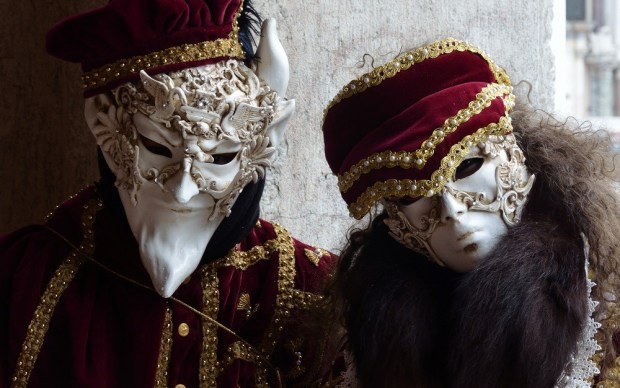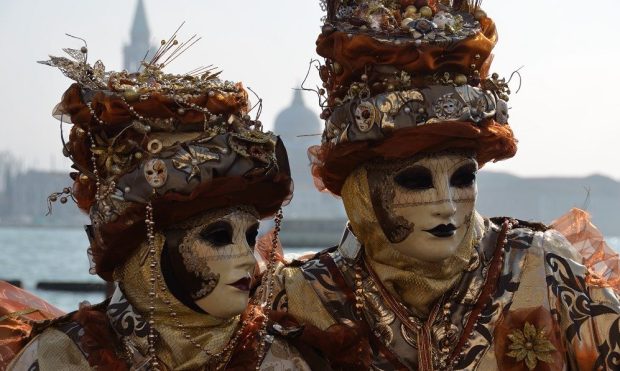Even on an ordinary day Venice feels unreal, suspended between sea and sky, a jumble of bridges and alleyways and damp brick walls, porphyry and gold mosaic, ogee arches and pinnacles of blindingly white marble. I’ve been there twice before, but had always dreamed of going to the carnival and so couldn’t have been more excited when my parents decided to make their first trip to Venice and asked me to come along as translator and guide.
We took no costumes or masks ourselves, although as it turned out we needn’t have been self-conscious: every third person wore a tricorn or a mask, even if they were the cheap kind you pick up from souvenir stalls, and such a large proportion of the city was wearing costume of some variety that the churches felt it necessary to put up notices explaining that masks were not permitted within. Speaking of costumes, there were three levels of attainment: tourists and visitors who’d put on a bauta or a jester’s mask with their jeans and sweaters; then the people who’d clearly made a bit of an effort and hired a costume or a cloak to go with their masks and tricorns; and finally the professionals. The amount of thought and money that must have gone into these high-quality costumes was unbelievable: I’ve seen silk, velvet, taffeta of every colour, cloth of gold, gauze, net and ribbons, seed pearls, leather and feathers galore. By the end of the first day I had begun to daydream of having the kind of gorgeous Rococo gown I’ve seen on the website of the wonderful Moretta Designs; by the second, I longed for a tabarro; and by the third I actually did end up buying another mask to add to my collection, from a temporary market in Campo Santo Stefano.

A masked figure by the Tetrarchs on the corner of San Marco © Richard Vowles
To my delight, the professional masquers wore their costumes and characters all day and the entire city was pervaded by the festival spirit. In any part of town you might suddenly turn a corner to find a pair of supercilious 18th-century gentlemen strolling off towards San Marco, or a Rococo lady in wig, mask and gown sipping espresso at a cafe table in a square. At any time of day, approaching San Marco, you would find at least twenty masked and costumed people strolling in the Piazza for the sole purpose of being admired and photographed by the rest of us. Promenading sedately around the square or posing in the arcades by Florian’s, they were always more than happy to be stopped for a photograph – and yet they were absolutely silent, the masks frozen in their grins or grimaces, the otherworldly character preserved.
The one exception, notable for his effervescent energy, was a lovely young man in 18th-century costume with a green feathered fan: whenever I saw him, he was either laughing or flirting with elderly women in one of several languages. But he was an exception. For the rest, their stately solemnity was infectious and I found myself half-bowing to them after I’d taken my photos – to which they responded in kind, with graceful bows, expressionless faces inclined or hands on hearts.
The Campo San Zaccaria proved to be another hotspot for masquers, less crowded than San Marco, where we found a whole host of gorgeously-costumed creatures posing in front of the glittering white marble of the church. A pair of elaborate figures in copper and gold draped themselves over a wellhead in a silent dumbshow, and when they drifted off into the crowds their places was taken by a nimble jester – so lithe it had to be a woman or a boy – who lent gracefully down and offered a red rose to each of us in turn. This was also where I saw my favourite costume of the whole carnival – a tall man made taller by heels, dressed all in black and festooned with blue-black plumes, wearing the most incredible headdress of silver, raven’s wings and peacock feathers. He wasn’t masked, but his whitened face and wide unblinking eyes were perfect. It was all the more frustrating that none of us was able to get a proper photograph of him as he stalked past, though I did manage to snap his astonishing headdress (see below). I felt as if I were in some fabulous fantasy world and, although I’d come prepared to find it all overly touristy and cynical, I really didn’t feel that was the case. The magic is still there.
The weather was just as astonishing as the carnival, in some ways. We had a couple of days of glorious sunshine, but on Monday it snowed and we ended up fighting our way along the Zattere towards the Salute in a blizzard so vicious that it veiled the Giudecca, stang our faces and chilled us to the bone. For the rest of our trip, snow lingered on roofs and on the covers of the boats in the canals and the bitter cold rose up from the damp paving stones through the soles of our shoes. (This was why the thick woollen tabarro looked so inviting.) Nevertheless, we refused to be daunted and I made sure that my parents saw as many of the key sights as possible. Everyone knows to go to the Basilica di San Marco and the Doge’s Palace when in Venice, but I discovered that a couple of my favourite sights were just as empty and deserted as they were when I first visited them. Both of them are mentioned in any guidebook you care to buy, but I suppose people tend to congregate around San Marco and they don’t get the visitors they deserve.
First there’s the Scuola di San Giorgio degli Schiavoni, a beautiful little scuola in the Castello quarter, north-east of San Marco, which was founded as a confraternity for the Slav community in Venice. Behind its modest entrance you find a lower hall decorated with a splendid cycle of paintings by Vittore Carpaccio (1502-7), telling the legends of three saints who were particularly dear to the confraternity: St George himself; St Jerome; and the less well-known St Tryphon, whom the custodian described on my first visit to the scuola as a ‘child exorcist’. Carpaccio’s paintings are beautifully detailed and his sacred scenes take place in a setting that has a flavour of Renaissance Venice. His Vision of St Jerome is one of his most contemplative and simple works, as the saint muses quietly in his study accompanied by the kind of small white lapdog you still see in Venice today; while St George and the Dragon is much brighter and crisper than the reproductions you see in books, showing the battle taking place in front of a splendid towered city, in a landscape scattered with the dismembered corpses of the dragon’s earlier victims.

Detailed moulded masks complete with red velvet and gold braid outfits © Richard Vowles
Although these two scuole – the Carmini and San Giorgio – don’t have the scale and grandeur of San Rocco, I love them because they’re more intimate and, yes, because they’re less well known. It’s always a privilege to stand alone in front of some great work of art – as I managed to, as well on that final morning, at the Frari, creeping in five minutes before the official opening time to sit in front of Titian’s Assunta and the Pesaro Altarpiece, before scurrying in to steal a few moments with Bellini’s radiant Madonna and Child. It was a super trip and, like all good trips, it has left me longing to return.
I have two recommendations of a more earthly sort: we stayed in a wonderful little hotel, Al Ponte Mocenigo, just south of San Stae and immensely convenient for the vaporetto. Run by Sandro and Walter, whose surnames I never learned, this hotel has only a handful of rooms, all decorated in old-fashioned Venetian style with great chandeliers of Murano glass. Without the advice of Sandro (or Walter?), we wouldn’t have known to go to Piazza San Marco at 5pm on Martedi Grasso to watch the ceremonial raising of the city’s gonfalone to the top of the campanile – all 20 metres of rippling scarlet cloth emblazoned with the golden winged lion – while a chorus sang the hymn of St Mark: a surprisingly stirring and wonderful conclusion to the days of licence, and a symbol of the beginning of Lent.
Without the recommendation of Walter (or Sandro?) we probably wouldn’t have discovered a fabulous little restaurant just round the corner from the hotel: the San Stae branch of Muro Venezia, where we found a friendly welcome and a delicious menu encompassing fish, meat and very good pizzas. It wasn’t grand (the soundtrack was dominated by the back catalogue of Wham), but it was local and honest and extremely good, and on our second visit we were recognised and given a warm greeting by our friendly waitress, Giovanna. If you’re ever over in the San Stae area, I thoroughly recommend it and, more specifically, I recommend the beef carpaccio followed by the taglioni with sea bass, accompanied by a carafe of their house white wine. I haven’t had a better meal on any of my visits to the city and I’ll definitely be heading back when I’m next in Venice.






What a wonderful trip. And great pics! I have only managed to spend one day in Venice so far in my life. I hope to get back some day.
Thanks maryb – although in the interests of fairness I should point out that most of the pictures in the first montage were my dad's. 🙂 I do hope you get to go back: I can only imagine the frustration of having to leave after a single day!
!!!!!!!!!!!!!! wow — so envious! I'd love to go to Venice someday — and during Carnival — amazing!
It was so beautiful, Audra. Definitely something I'd recommend. Though I'm sure it's even more fun if you take a costume. 🙂